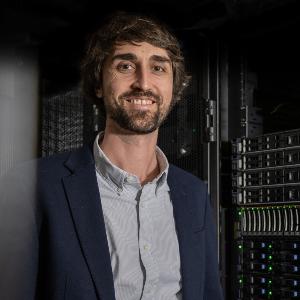Algorithms to peek into the universe
3 Jan 2022
Astrophysicist Daniel Grün uses artificial intelligence to explore the influence of dark matter and dark energy on the Universe.
3 Jan 2022
Astrophysicist Daniel Grün uses artificial intelligence to explore the influence of dark matter and dark energy on the Universe.
Dirt on the lens is the last thing an astronomer needs — it ruins any observation. A piece of dirt in front of the lens, on the other hand, or a few obstacles that deflect the light off its path, are just the thing for Daniel Grün.
Grün, who started the Chair of Astrophysics, Cosmology, and Artificial Intelligence in July, wants to see things no human has seen before: He’s looking for traces of two phenomena that physicists call dark matter and dark energy. One holds galaxies together, the other drives the Universe apart. Apart from this simplistic explanation, the properties of dark matter and dark energy have so far been very successful in eluding physical description. Daniel Grün is therefore drawing on an unusual toolset in his search: an uneven cosmic window pane, vast numbers of observed galaxies, loads of statistics, and increasing amounts of artificial intelligence.
We do have a very successful model of our Universe that aptly describes all our observations. But at the same time, we know that this model is wrong, that it is incomplete.Prof. Daniel Grün
“Cosmology is in a tricky place,” says Grün. “We do have a very successful model of our Universe that aptly describes all our observations. But at the same time, we know that this model is wrong, that it is incomplete.” Dark matter and dark energy are at the core of the model — but nothing more is known about what they actually are. The real, physical properties of the ‘dark universe’ ought to leave traces — in the model and in reality.
Gravitational lensing is the name of the approach Grün wants to use to discover these traces. Weak gravitational lensing, to be precise. The method is supposed to provide clues to what is wrong with the successful but unexplained model of the Universe. The reasoning behind it is simple: Whenever light from distant galaxies has to pass huge masses on its way towards Earth — other galaxies, galaxy clusters, black holes — their gravitational pull deflects the light waves slightly. In extreme cases, the image of a distant galaxy can even assume a ring-shaped form — as if astronomers were observing the galaxy through the bottom of a glass.
The effect Grün is banking on is more subtle. “The effect of weak gravitational lensing is like looking through a window pane that is not perfectly smooth,” says the physicist. If the glass isn’t perfectly flat, if it has slight ripples in it, then the world behind it looks a little bit distorted. The same applies to looking into the Universe — the only difference being that the unevenness of the pane is replaced by the unevenly distributed, not directly visible matter that sits between the observer and the distant galaxies and distorts the rays of light.
“In some ways, though, this effect is extremely frustrating,” says Daniel Grün. The problem is that the distorted image of a single galaxy tells you nothing — as little as the image of an apple in your neighbor’s garden that you happen to spy through an uneven window pane. It’s only when you compare it against an undistorted image of the apple that you can conclude what’s wrong with the window pane. But in the cosmos, there’s no such comparison to make: There is only one Universe and only one cosmic window pane.
Astronomers must therefore find other ways to help them achieve their goal, for instance by studying numerous galaxies: If two of these structures — one close to Earth, another far away — can be observed in the sky in the same line of sight and if the images of both galaxies are slightly distorted, this could indicate an unevenness in the cosmic window pane: an unknown mass between the galaxies and the Earth. But just two distorted galaxies are not enough to draw any reliable conclusions from. More are needed. Many more.
To this end, more than 300 million galaxies have been observed by the Dark Energy Survey, a systematic sky survey for which Grün was until recently analyzing the weak gravitational lensing effect. For six years, a camera located at the Cerro Tololo Inter-American Observatory in Chile systematically scanned about one-eighth of the night sky. The result is not only an impressive map full of galaxies, the largest and deepest image of the sky to date. It is also the ideal basis for analyzing distorted images of all these galaxies using statistical methods — and thus for drawing conclusions about unseen, or dark, matter.
The result of this analysis is what Grün calls “the best picture yet of the distribution of matter in the grown-up Universe.” However, this image alone does not help in the search for dark phenomena and mistakes in the cosmological model. Fortunately, there is also a baby picture of the distribution of matter. It was taken about 380,000 years after the Big Bang, burned itself into the cosmos and reaches the Earth today from all directions. Scientists therefore call it cosmic background radiation.
What Daniel Grün is asking now is: Do those two images fit together? If we take the current models of cosmology, does the baby picture inevitably become the picture of the adult Universe? Or are there any deviations, any irregularities, which could give clues to the properties of the dark effects?
There is no clear answer. “Analysis shows that the current structure is a bit less pronounced than we would expect,” says Grün. Just a bit, though. Daniel Grün compares the dilemma to the scenario of a baby born with basketballer genes who is predicted to be 7 feet tall when fully grown. But they actually grow to be only 6 feet 6 inches tall. Still a basketballer, but are the missing inches just a statistical fluctuation or an effect we don’t understand? “Unfortunately, there is no simple answer to that so far, no elegant solution that explains everything,” says Daniel Grün.
And so the search continues. With new telescopes, but also with new ideas, new tools. The Dark Energy Spectroscopic Instrument (DESI), for example, which Grün recently started working with, can take pictures of 5,000 galaxies at once. Not only that: The camera, installed at the Kitt Peak Observatory in Arizona, also produces fingerprints of the light from the individual galaxies. Physicists can use these to calculate exactly how far away the structures are. A three-dimensional map of the Universe behind its cosmic window pane is thereby being created. And this could make it possible to obtain significantly more precise statistics on the distribution of matter.
The Legacy Survey of Space and Time, a sky survey being conducted at the new Vera C. Rubin Observatory in Chile, and the European space telescope Euclid are taking a different approach. Their aim is to look even deeper into space and chart billions of galaxies on their maps. They hope for more galaxies, more distorted images, better results.
“That’s one side of it, that’s the data,” says Daniel Grün. “But we also need to improve on the methods side.” When scientists are looking for tiny effects, for inconspicuous indications of unusual distribution of matter, they must not make systematic mistakes. They also have to resort to new and previously unused statistical tricks. And they need to understand all this as best they can. “Even though a lot of work goes into building new tools, we need to be putting at least as much energy into analyzing and understanding the data,” says Grün. “That’s essential.”
Artificial intelligence, or AI for short, is expected to make an important contribution here, which is partly why Grün’s chair was established under the State of Bavaria’s AI Initiative. That said, gravitational lensing is not helped by the artificial intelligence everyone is familiar with — say, the automatic image recognition you get on your cell phone: For that technology, huge numbers of pictures are used to train algorithms to decide whether the image in an unknown photo is a dog or a cat.
The problem in cosmology is a different one. Here, there are huge amounts of data out of which, on an individual level, almost nothing can be discerned — images of tiny galaxies which, taken on their own, tell us nothing. The task in cosmology is to decide whether these are characteristically distorted or not. “Basically, what we have is a hundred million tiny images where you can’t tell if it’s a dog or a cat. And what we want to know is whether you can see a few more dogs or more cats,” says Grün.
But the physicist, who’s just back from six years working at Stanford in California, wants to try and do even more with the computers at the Munich University Observatory (USM): The analysis of hundreds of millions of galaxies presents an almost insoluble challenge for even the best computing systems. In order to reasonably be able to compute such volumes of data, the data need to be cut up into manageable chunks and described by models. This is where the artificial intelligence comes in: It’s AI’s job to put each galaxy into one of many different groups based on what it looks like, so that these groups can then be analyzed.
Intelligent algorithms won’t just recognize and categorize galaxies. They will also develop their own models — such as models of how matter is distributed in the universe and how galaxies have evolved. Then, the results from the computer can be compared against real observational data.
We have just now reached the point where AI is right at the heart of this kind of cosmological analysis. We are at the point where nothing is possible any more without artificial intelligence.Daniel Grün
This is a new kind of cosmology — the kind of paradigm shift that other disciplines like particle physics have long since gone through. Gone are the days of astronomers looking through a telescope alone, discovering new objects. Now it’s all about big machines, international collaborations, and data, data, data.
For scientists, what this means is that their tools and analyses must always be a little bit ahead of the exponentially growing flood of data. Not too far ahead, otherwise it would be a waste of effort, but not too near either, otherwise the flood will overtake them and the data will be useless. Computers are proving increasingly helpful. “We have just now reached the point where AI is right at the heart of this kind of cosmological analysis,” says Daniel Grün. “We are at the point where nothing is possible any more without artificial intelligence.”
Text: Alexander Stirn

© LMU
Prof. Dr. Daniel Grün is Chair of Astrophysics, Cosmology, and Artificial Intelligence at LMU and works at Munich University Observatory (USM). Born in 1986, Grün studied physics at LMU Munich, where he also completed his doctorate. He was a postdoctoral researcher at Stanford University, USA, and, as a Panofsky Fellow, led a junior research group at Stanford’s SLAC National Accelerator Laboratory and the Kavli Institute for Particle Astrophysics and Cosmology (KIPAC), before returning to LMU in the summer of 2021.

Read more articles on the topic "Back to life: A post-lockdown generation" in the current issue of "INSIGHTS. Magazine".
You can also read selected stories in the online section of INSIGHTS.